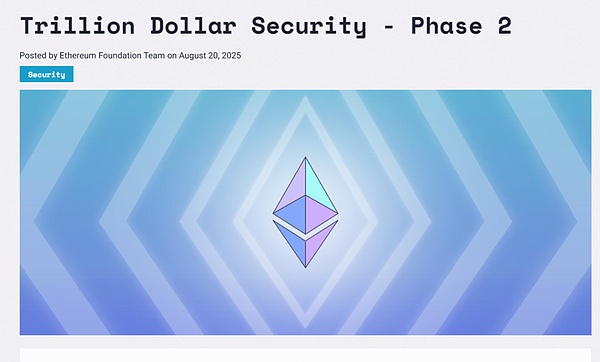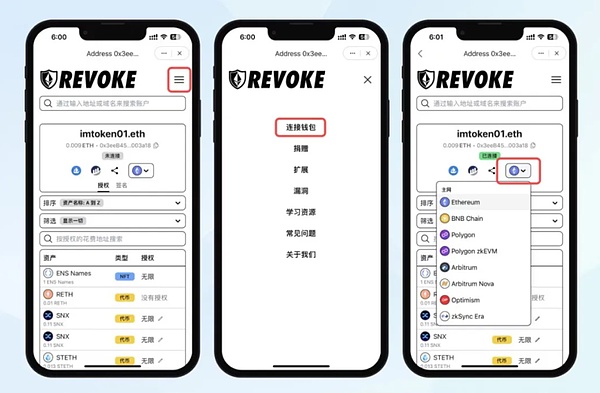
“Ronin is coming home to Ethereum.”
On August 15, Ronin, a side chain that was expanding its DeFi business and consumer DApps several months ago, suddenly announced that it had “go home” and planned to transform from an Ethereum side chain to an L2 solution.
At the same time, the Ethereum Foundation is also promoting another landmark event – the “Triple Billion USD Security Plan” (1TS) has officially entered the second phase, with the focus from the underlying consensus and security mechanism to wallet user experience and application layer availability.

The spring river is warm and the duck prophet, the next wave of the Ethereum ecosystem, the dual upgrades of security and experience are being implemented.
1TS Phase 2: The transition from safety to experience
As early as May this year, the Ethereum Foundation (EF) released the “Triple Billion Dollar Security Plan” (1TS), with the goal of making Ethereum the ultimate settlement layer that can carry billions of users and trillions of dollars in economic activity.
Subsequently, EF adjusted its internal governance structure one after another and released its first report of 1TS in June, summarizing the main security issues currently facing Ethereum into six major categories—User experience (UX), smart contract security, infrastructure and cloud security, consensus protocol security, security incident response and mitigation mechanism, social layer and governance security,Marks the beginning of Ethereum to systematically sort out and solve ecological security challenges (Extended reading “Is user experience also a security issue?Understand the UX challenge under the trillion-level security blueprint of Ethereum》).
On August 20, the Ethereum Foundation issued another document, officially announcing the launch of the second phase of the 1TS plan, clearly stating that the core goal will be shifted from underlying security to user experience and wallet security. The focus of the action includes:
-
Work with Walletbeat to develop minimum security standards for Ethereum wallets, including transparent transactions, anti-intrusion interfaces and other requirements;
-
Solve blind signing problems by supporting projects such as Verifier Alliance (VERA) and improve transaction decoding capabilities;
-
Establish an open source smart contract vulnerability database to help developers detect code vulnerabilities before deployment;

In addition, EF also encourages the community to develop “minimal wallets” for non-technical users, as well as enterprise-level solutions that meet compliance and privacy needs, further reducing the threshold for use of Ethereum.
In other words, 1TS has entered practical operation from the Blueprint, EthereumNot only should we continue to be the safest infrastructure, but we should also become the most easy-to-use and most trustworthy public base to achieve the siphon effect.After all, whoever can provide higher security standards and smoother user experience will concentrate on where funds, users and developers.
Safety and experience, build a new moat
“If users cannot understand the transactions they signed and cannot properly manage the keys, then no matter how safe Ethereum is, the user’s experience is still dangerous.” This also reveals that the fundamental goal of 1TS’ second phase is to make the interaction between wallets and applications change from security problems to “security guardrails.”
Ronin’s “Going Home” is a typical signal. It once chose to leave due to high Gas and complex interactions to build an independent public chain. However, with the maturity of Rollup technology and the dual upgrade of Ethereum security and experience, Ronin realized that it is more valuable to re-connect to the Ethereum ecosystem:
Returning to Ethereum means instant access to mature liquidity, unified standards, enjoy the richest development tools and standards, and obtain the most stable security endorsement, thereby reducing costs and improving the experience.
Instead of struggling independently, it is better to reconnect to Ethereum’s huge ecosystem.
From this perspective, if Ethereum in the first stage relies on “security” to win the trust of core applications such as DeFi, stablecoins, and NFT, then when it enters the second stage, what it truly shows is the siphon effect on user experience and ecological prosperity.
All of this is the strategic intention of “1TS Phase 2” – wallet blind signing solutions, the launch of minimum security standards, and the establishment of vulnerable databases. They are not only security measures, but also experience upgrades. They will jointly lower the threshold for user use, allowing Ethereum to move from “only geeks and native users to use it” to “anyone/institution around the world can use it with confidence.”
Ronin is not the first, nor will it be the last one. Today is the relocation of the game public chain. Tomorrow, more public chains that have chosen to “independently develop” will return to Ethereum and transform into L2. In the end, Ethereum’s settlement level status will become increasingly stable and the ecological scale will be further expanded.
After safety, experience is the new moat. Once Ethereum completes the construction of this moat, it will not only be the first choice for developers, but will also become the default entrance for global users.
Wallet: The first line of defense for trillion-dollar applications
If Ethereum’s 1TS is a systematic upgrade project, then the wallet is the first cornerstone of this project. Therefore, EF clearly supports developers and contributors to establish minimum security standards for wallets:
Promote transaction readability and simulation to completely solve the blind signing problem, and also establish vulnerability databases and development tools to help wallets and DApps discover problems before they go online.This series of actions is actually building a “guardrail” for the wallet, so that they are no longer just an entrance, but a trusted gatekeeper for user assets and experience.
From the user’s perspective, the future wallet will no longer be a “complex encryption tool”, but will gradually evolve into a “default secure on-chain financial assistant”. From the developer’s perspective, the standardization and security of wallets also mean that ecological applications can reach users faster and lower risks.
For today’s wallet service providers, it is both a challenge and an opportunity.Taking imToken as an example, the continuous iteration around transaction readability, authorization management center and risk identification mechanism is exactly in line with the direction proposed by EF:
-
For common contract call requests, the signature request has been readable, which can clearly display information such as authorization object, amount, and whether it is unlimited authorization, help users identify the real operation content, and significantly reduce the risk of users missigning due to lack of understanding;
-
The authorization management page inherits the function of revoke, allowing users to quickly view and manage the authorization history of all DApps, and supports one-click revocation;
-
It integrates the on-chain address blacklist system, DApp risk scoring mechanism and third-party security services, and can identify malicious links, disguised front-end, phishing contracts and other risk sources in advance;

The wallet is not only an entrance, but also the first line of defense for whether Ethereum can support trillion-dollar applications in the future. Whoever can take the lead in benchmarking standards, establish guardrails, and conduct systematic responses will become a real beneficiary in the “return wave”.
Today’s Ethereum is no longer just the “world’s largest smart contract platform”, it is gradually upgrading to the settlement layer and infrastructure of global trillion-dollar applications.
It can be foreseen that in the next few years, Ethereum will not only continue to dominate the crypto-financial world, but will also gradually integrate into a wider range of real-life finance and daily application scenarios, from cross-border payments to corporate treasury, from game entertainment to social networks.
As witnesses, we will directly witness that trillion-dollar innovation and applications are redefined on Ethereum.







